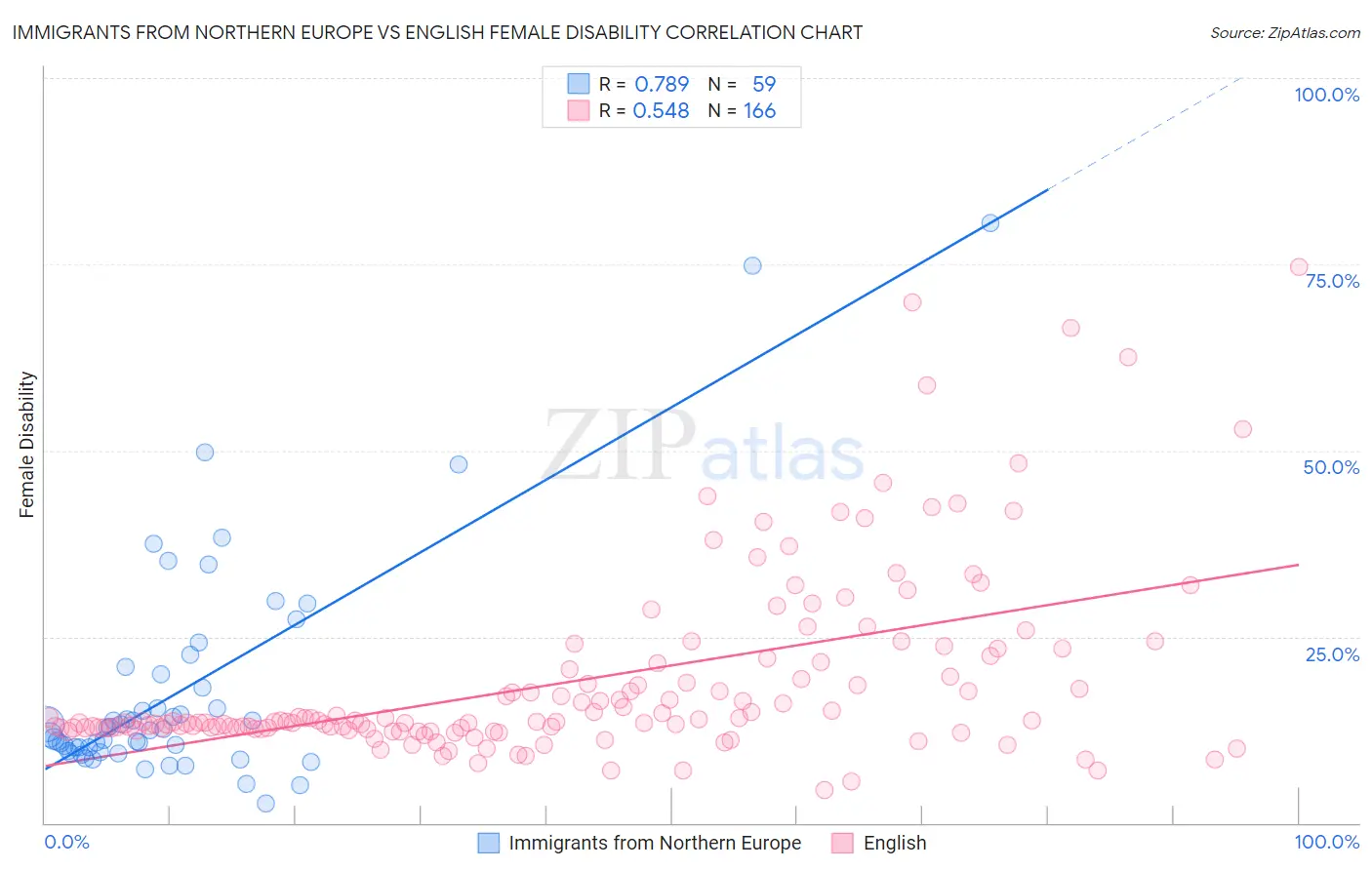Immigrants from Northern Europe vs English Female Disability
COMPARE
Immigrants from Northern Europe
English
Female Disability
Female Disability Comparison
Immigrants from Northern Europe
English
11.6%
FEMALE DISABILITY
99.4/ 100
METRIC RATING
95th/ 347
METRIC RANK
13.1%
FEMALE DISABILITY
0.0/ 100
METRIC RATING
283rd/ 347
METRIC RANK
Immigrants from Northern Europe vs English Female Disability Correlation Chart
The statistical analysis conducted on geographies consisting of 477,174,714 people shows a strong positive correlation between the proportion of Immigrants from Northern Europe and percentage of females with a disability in the United States with a correlation coefficient (R) of 0.789 and weighted average of 11.6%. Similarly, the statistical analysis conducted on geographies consisting of 579,455,511 people shows a substantial positive correlation between the proportion of English and percentage of females with a disability in the United States with a correlation coefficient (R) of 0.548 and weighted average of 13.1%, a difference of 12.5%.

Female Disability Correlation Summary
| Measurement | Immigrants from Northern Europe | English |
| Minimum | 2.6% | 4.3% |
| Maximum | 80.5% | 74.6% |
| Range | 77.9% | 70.3% |
| Mean | 17.9% | 19.1% |
| Median | 12.6% | 13.6% |
| Interquartile 25% (IQ1) | 9.7% | 12.7% |
| Interquartile 75% (IQ3) | 19.9% | 21.5% |
| Interquartile Range (IQR) | 10.2% | 8.8% |
| Standard Deviation (Sample) | 15.2% | 12.5% |
| Standard Deviation (Population) | 15.1% | 12.5% |
Similar Demographics by Female Disability
Demographics Similar to Immigrants from Northern Europe by Female Disability
In terms of female disability, the demographic groups most similar to Immigrants from Northern Europe are Immigrants from Brazil (11.6%, a difference of 0.070%), Immigrants from Sierra Leone (11.6%, a difference of 0.10%), Immigrants from Czechoslovakia (11.6%, a difference of 0.20%), Immigrants from Romania (11.6%, a difference of 0.21%), and Immigrants from Zimbabwe (11.6%, a difference of 0.21%).
| Demographics | Rating | Rank | Female Disability |
| Yup'ik | 99.5 /100 | #88 | Exceptional 11.6% |
| Vietnamese | 99.5 /100 | #89 | Exceptional 11.6% |
| Immigrants | Romania | 99.5 /100 | #90 | Exceptional 11.6% |
| Immigrants | Zimbabwe | 99.5 /100 | #91 | Exceptional 11.6% |
| Immigrants | Czechoslovakia | 99.5 /100 | #92 | Exceptional 11.6% |
| Immigrants | Sierra Leone | 99.4 /100 | #93 | Exceptional 11.6% |
| Immigrants | Brazil | 99.4 /100 | #94 | Exceptional 11.6% |
| Immigrants | Northern Europe | 99.4 /100 | #95 | Exceptional 11.6% |
| Immigrants | Russia | 99.0 /100 | #96 | Exceptional 11.7% |
| Koreans | 99.0 /100 | #97 | Exceptional 11.7% |
| Uruguayans | 98.8 /100 | #98 | Exceptional 11.7% |
| Immigrants | Philippines | 98.6 /100 | #99 | Exceptional 11.7% |
| Immigrants | Uruguay | 98.5 /100 | #100 | Exceptional 11.7% |
| Immigrants | Costa Rica | 98.4 /100 | #101 | Exceptional 11.7% |
| Immigrants | South Eastern Asia | 98.4 /100 | #102 | Exceptional 11.7% |
Demographics Similar to English by Female Disability
In terms of female disability, the demographic groups most similar to English are Welsh (13.1%, a difference of 0.0%), U.S. Virgin Islander (13.1%, a difference of 0.080%), Irish (13.1%, a difference of 0.12%), Hmong (13.1%, a difference of 0.13%), and Bangladeshi (13.1%, a difference of 0.18%).
| Demographics | Rating | Rank | Female Disability |
| Immigrants | Dominica | 0.1 /100 | #276 | Tragic 13.0% |
| Spanish | 0.1 /100 | #277 | Tragic 13.0% |
| Scottish | 0.1 /100 | #278 | Tragic 13.0% |
| Arapaho | 0.1 /100 | #279 | Tragic 13.0% |
| Irish | 0.1 /100 | #280 | Tragic 13.1% |
| U.S. Virgin Islanders | 0.1 /100 | #281 | Tragic 13.1% |
| Welsh | 0.0 /100 | #282 | Tragic 13.1% |
| English | 0.0 /100 | #283 | Tragic 13.1% |
| Hmong | 0.0 /100 | #284 | Tragic 13.1% |
| Bangladeshis | 0.0 /100 | #285 | Tragic 13.1% |
| Fijians | 0.0 /100 | #286 | Tragic 13.1% |
| Yaqui | 0.0 /100 | #287 | Tragic 13.2% |
| Whites/Caucasians | 0.0 /100 | #288 | Tragic 13.2% |
| Tlingit-Haida | 0.0 /100 | #289 | Tragic 13.2% |
| Immigrants | Yemen | 0.0 /100 | #290 | Tragic 13.2% |